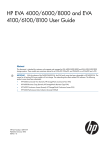Download Compaq 353803-B22 - StorageWorks Modular Smart Array 1000 SAN Starter QuickSpecs
Transcript
My First SAN solution guide 3rd edition—now featuring IP SAN solutions With data doubling in size every year, companies are looking for new ways to manage their growth and control costs. My First SAN offers simple advice on how to implement affordable, reliable and easy networked storage solutions designed to give your business a competitive edge. Part 1: Understanding the SAN ..................................... 3 Part 2: Assessing your options ....................................... 9 Part 3: Choosing your solution.......................................16 Part 4: Complete your knowledge..................................19 Your questions answered .............................................20 Jargon buster ..............................................................22 How can this guide help? This guide has been designed specifically to help you understand what a SAN does and choose the solution that’s right for your business. The main focus will be on the HP StorageWorks Modular Smart Array (MSA) family. Looking for storage information beyond the SAN? Part 1: Understanding the SAN This guide is part of the HP Simply StorageWorks solution initiative, which offers detailed comprehensive information on the complete HP storage portfolio for small and mediumsized businesses. Other HP solution guides include: (pages 3-9) In the opening pages, we look at what a SAN is, how it works and what it can do for you. • Easy as NAS—everything you need to know about network attached storage (NAS) solutions from HP, built on HP ProLiant storage servers. 5983-0748EN. Part 2: Assessing your options • HP ProLiant Storage Servers Configuration Poster 5983-0754ENA1. (pages 10-17) The second part examines the different SAN options available from HP, and how they work within four different business scenarios. Part 3: Choosing your solution (pages 18-21) In this part, we look at pre-configured solution kits, a selection of specific configurations and an easy decision tree to help you choose what’s right for you. Learn more about Easy at NAS at: www.hp.com/go/nas • Ultimate Business Protection—helping you to achieve the level of data protection that’s right for your business. Learn more about Ultimate Business Protection at: www.hp.com/go/ubp Part 4: Complete your knowledge (pages 22-27) Complete your understanding of SAN technology with quick answers to commonly asked questions and simple definitions of the key technology terms. Plus, see how HP Services can complement your solution with compelling service offerings. 2 Part 1: Understanding the SAN What is a storage area network? The simplest way of understanding a storage area network is to compare it to an already popular type of IT infrastructure solution—the local area network (LAN), which enables multiple PCs to share key IT resources such as applications, servers, shared files and printers. SANs provide similar resource sharing, but are specifically designed for servers to share storage devices such as disk arrays or tape libraries. The majority of SANs deployed today are built on the fibre-channel (FC) protocol, which offers high levels of performance and availability for demanding users. However, there are now also IP SAN solutions based on the iSCSI protocol, which enable smaller IT environments to benefit from shared network storage at a particularly favorable price. What will it do for you? Whether you choose fibre channel or iSCSI, moving to a SAN will help you to store and manage growing amounts of data more efficiently, while simultaneously cutting operational and management costs. Benefits include: • Online scalability—so you can add storage with ease to meet changing capacity requirements • High levels of availability—enable your data and applications to be fully accessible at all times, even during backup • Simple and centralized management—saving you vital human resources • High utilization of disk capacity—by creating a central pool of storage, you can double capacity utilization from 40 up to 80 percent, which improves cost efficiency • Faster data restoration—to return your business to full productivity 3 SAN components A B C D E A-E Multiple servers SAN Infrastructure Consolidate Server Storage into Storage Array Disk storage Tape storage SAN management software SAN components Servers Multiple servers, from different vendors, running different operating systems can all be connected to a SAN. Servers with a fibre channel SAN connection require a special FC card called a host bus adapter (HBA) in each connected server. In an IP SAN, you can use a standard Ethernet NIC. Benefit of a SAN: Allows multiple servers to share storage for greater efficiency and increased availability. SAN infrastructure Ethernet LAN network SAN: FC or IP (Ethernet) network Storage capacity Disk storage A disk array can be seen as a centralized storage pool for servers. Data from multiple servers is stored in dedicated areas called logical unit number (LUNs), and can be protected against data loss in the event of multiple disk failures using RAID protection. Redundant array controllers assures that servers can access their data, even if one controller or network connection fails. In addition, the modular design of disk storage allows you to grow capacity as you require. Benefit of a SAN: Provides increased availability and capacity utilization, plus simplified management, by consolidating data in a disk array. The SAN infrastructure (also called “fabric”) comprises the hardware, cabling and software components that enable data to move into and within the SAN. Principally, these are network cards (fibre channel HBAs or Ethernet NICs) and switches. Switches can detect failed or congested connections and intelligently reroute data to the appropriate device. When linked together (cascaded), they increase the number of available SAN connections—providing greater performance and resilience against individual connection failures. You can choose a single connection or a dual, redundant connection that performs a failover should one connection break. Benefit of a SAN: Creates a high-performance, resilient infrastructure that can easily be modified as your needs change. 4 Tape storage Within a fibre channel SAN, any disk storage (whether it’s an external disk array or internal to the server) can be backed up directly to a tape library. This provides a fast and dedicated pathway for data backup, and frees the corporate LAN to perform its primary functions with greater efficiency. Due to their lower network speed, IP SANs should preferably pass data traffic through a backup server to a direct-attached tape library. Tape-based backup can be combined with disk-based backup—e.g., via a virtual library system (VLS)—to improve recovery processes and optimize slow server backups. Benefit of a SAN: Reduces your backup window and simplifies recovery with central management. Management software Although it is often overlooked, the management software is perhaps the most important part of any SAN. It helps you configure and enhance individual components for the best setup. It can then monitor the entire SAN area for performance bottlenecks and areas of potential failure. Storage management software also automates timeconsuming tasks such as data backup, and may provide usage statistics that enable consumption-based allocation of IT costs. In addition, virtualization functionality lets you manage all available storage as one virtual pool, regardless of where it’s located. Benefit of a SAN: Enhances efficiency helping you manage your consolidated storage from one location. HP Storage Essentials (SE) is the first open, standards-based modular suite of storage products designed to integrate into the HP unified server-storage-management platform, HP Systems Insight Manager (SIM). SE also leverages HP-SIM’s integration with HP OpenView software. By designing SE in a manner that incorporates tight and seamless integration into HP Systems Insight Manager and HP OpenView products, customers can utilize an essential building block on the path to creating a comprehensive unified infrastructure-management environment that is critical to developing a truly Adaptive Enterprise. Integration with System Insight Manager greatly simplifies and enhances a customer’s HP Storage Essentials’ usability. The integration results in a single-sign-on mechanism for server and storage management, thus greatly reducing the effort around the task of security management. Since the integration is at the architecture level, the customer only manages a single server for hosting Storage Essentials and SIM. Benefit of a SAN: HP Storage Essentials delivers integrated heterogeneous functionality for network (DAS, SAN, NAS) management, storage resource management, provisioning and application infrastructure monitoring. The suite consists of HP Storage Essentials Enterprise Edition and a portfolio of value added plug-ins. The architecture and interfaces are built on industry standards. 5 A SAN makes it easy to increase availability Today’s IT environments require increasingly high levels of availability at all times. SANs can offer 24x7 availability thanks to a fully redundant architecture. The following elements are building blocks for increased SAN availability. Servers Servers Servers Storage Server clustering Configuring two or more servers in a cluster provides the following advantages: a cluster distributes processing requests evenly between servers in the cluster (load balancing), and allows a recovery server to take over the operations of a primary server should a failure occur. Clustered servers need access to the same data, which requires an external storage system. A SAN is recommended as it provides multiple storage connections and scalability to meet changing needs. Storage Storage Multi-pathing The connection between server and networked storage solution has several components—HBA/NIC, switch, cables, array controller. If one breaks, your connection will fail. Multi-pathing guards against this. With redundant components, traffic can be swapped from one component to the other should a failure occur. Multi-pathing software like HP StorageWorks Secure Path, Microsoft® MPIO or QLogic failover detects failed connections and initiates automatic failover. Choose the right SAN infrastructure Fibre channel SANs: for larger, more demanding environments SANs have traditionally been built on a fibre channel infrastructure. Because the fibre channel protocol is specifically designed for storage networks, it provides a high level of performance and reliability between servers and storage devices. For environments where high performance and the highest level of availability counts (i.e., in data centers), but also when fully integrated SAN backup is required, fibre channel SANs will remain the ideal choice over the coming years. Benefit of a SAN: • Improved availability of mission-critical applications – Reduce scheduled and unscheduled downtime – Increase application disaster tolerance • Improved storage utilization – Increase efficiency of valuable IT assets – Gain economies of scale • Improved availability of enterprise information – Increase efficiency of IT systems – Enable more efficient business processes Data replication Data replication enables access to data—even if your entire storage system fails—by continuously copying it to a remote secondary array (e.g., at a second remote location). While higher-end environments perform this directly between two disk arrays, smaller environments are more suited to replication between servers connected to a SAN over an IP network. This enables one-to-one, one-to-many and many-to-many replication, and data is synchronized in incremental blocks to reduce network traffic. • Foundation for disaster tolerance – A SAN enables “always on” infrastructure IP SANs: the technology for smaller businesses For smaller IT environments looking for an affordable and simple SAN solution, IP SANs are ideal. They allow you to share stored data over a low cost Ethernet infrastructure using a protocol called iSCSI. A 1 Gb/s Ethernet network will provide sufficient bandwidth to connect several servers to a SAN storage device (using either standard network interface cards or optional TOE cards that offload network tasks from servers with high CPU loads). To enable data security and performance, it is recommended that your IP SAN and LAN are kept separate. In a typical small IT environment, this requires just a single unmanaged switch—or you could even connect your servers to the storage device directly. Advantages of an IP SAN • Get the benefits of shared storage for less. IP SANs have vastly reduced infrastructure costs compared to fibre channel SANs, so you can save up to 50 percent on the total solution • IP SANs allow you to extend the benefits of shared storage to smaller departments and remote locations • More effective storage management – Increase CONTROL of storage environment – Enables enterprise wide management 6 Primary storage FC/SCSI disk storage Secondary storage SATA/FATA disk storage Choose the appropriate disk technology for your environment Serial ATA versus SCSI and fibre channel disks SCSI disk technology is the right choice for entry-level networked storage, as it offers the same advantages that fibre channel disks provide to large enterprise disk arrays. In addition, it offers a simple migration path from storage directly attached to servers (DAS) to a storage area network (SAN)—a key HP offering explained on the following page. Serial ATA (SATA) disks available for HP StorageWorks MSA arrays provide a much lower cost per megabyte than SCSI or fibre channel disks. Serial Attached SCSI (SAS) is the next-generation storage solution for your enterprise environment. SAS integrates two established technologies, combining proven utility, reliability and performance attributes of the SCSI protocol with the performance advantages of serial architecture. Serial Attached SCSI allows the customer ultimate configuration flexibility and simplicity in their storage environments. SAS solutions accommodate both low cost bulk storage Tertiary storage Tape storage Optical archiving (ATA) or performance and reliability in mission critical applications (SCSI). This reduces customer investment while at the same time increases customer choice and ease of deployment. Ultimately, customers can buy one server or storage solution and customize the technology to fit their unique needs. SATA is not intended as a replacement technology. SCSI or fibre channel disks remain a better choice for reliable, high performance storage. However, if you want costeffective storage for infrequently accessed data—such as data repositories or reference information—then SATA is perfect. Tiered storage environments In a tiered storage environment, you can match your data to storage that has an appropriate level of performance and availability—giving you a lower cost of ownership, without any negative impact on your business. Here’s how it could work in a typical disk-to-disk-to-tape environment: • Data with the highest availability and performance requirements is stored in tier one on SCSI or fibre channel disks • The second tier stores infrequently accessed data (e.g., disk-to-disk backup copies) on SATA disks • Tier three comprises tape-based backup copies, or even archived data on optical storage 7 DAS-to-SAN migration with HP Smart Array technology HP ProLiant server with internal drives Option 1: direct migration into a SAN or Disk enclosure connected through Smart Array controller HP MSA1000 HP MSA1500 HP MSA1510i Option 2: simple storage consolidation without fibre-channel SAN or Further upgrade: optional conversion to a MSA1000 SAN by upgrading controller HP StorageWorks RA4100 HP MSA500 HP MSA1000 controller HP makes it easy to migrate data to a SAN DAS-to-SAN migration With HP’s unique DAS-to-SAN migration, you can move HP ProLiant server-based (direct attached) storage to an HP StorageWorks MSA device quickly and easily. The same HP Smart Array technology used in your ProLiant server is used by the MSA to automatically recognize the configuration of your data—including RAID level—thus reducing downtime during migration. No other solution on the market today makes it this simple to consolidate your storage. • Investment protection—Re-use existing SCSI universal disk drives in your new MSA array* • Simplicity—Smart Array technology is designed to make it quick and easy to access your data from its new location • Flexibility—Migrate at your own speed with the MSA family—start with simple external storage (MSA500), then move to a full SAN when you’re ready** • Familiarity—The MSA family uses the same management tools as existing ProLiant systems, helping to reduce training costs * HP always recommends a full backup prior to any kind of migration. For detailed process information on how to perform DAS-to-SAN migration, plus hardware requirements, please visit: www.hp.com/go/myfirstsan ** Simple upgrade/conversion: exchange the controller, then connect the array (e.g., with the embedded switch) and the servers (via fibre channel HBA) to the network. 8 Part 2: Assessing your options HP StorageWorks storage array systems The seamless portfolio for storage consolidation HP StorageWorks MSA1510i HP StorageWorks MSA1500 HP StorageWorks MSA1000 Description Flexible, scalable iSCSI SAN solution Flexible, scalable fibre channel SAN solution Affordable fibre channel SAN solution Drive count/maximum 0/96 0/96 14/42 Maximum storage 48 TB 48 TB 12 TB Expansion options MSA30, MSA20 MSA30, MSA20 MSA30 Host interface 1 GB iSCSI 2 GB/1 GB fibre channel 2 GB/1 GB fibre channel Drive interface SCSI/SATA SCSI/SATA SCSI Form factor/height 2U, 3.5" 2U, 3.5" 4U, 3.5" OS support Windows Windows, Linux, NetWare, HP-UX, SCO Windows, Linux, NetWare, HP-UX, SCO, Tru64, OVMS Warranty 3-1-1 3-1-1 3-1-1 Other support features SAN backup, OpenView Storage Mirroring (OVSM), Systems Insight Manager Clustering, SAN backup, OVSM, Systems Insight Manager Clustering, SAN backup, OVSM, Systems Insight Manager HP StorageWorks MSA500 G2 HP StorageWorks MSA50 HP StorageWorks MSA30 HP StorageWorks MSA20 Description Affordable shared storage solution SAS drive enclosure SCSI drive enclosure SATA drive enclosure Drive count/maximum 14 10/20 14 12 Maximum storage 4.2 TB 720 GB/1.4 TB 2 TB 3 TB Expansion options N/A MSA50 N/A N/A Host interface U320 SCSI 3G SAS U320 SCSI U320 SCSI Drive interface SCSI 3G SAS/SATA SCSI SATA Form factor/height 4U, 7" 1U, 1.75" 3U, 5.25" 2U, 3.5" OS support Windows, Linux, NetWare Windows, Linux, NetWare Windows, Linux, NetWare, HP-UX, OVMS Windows, Linux, NetWare Warranty 3-3-3 3-0-0 3-0-0 3-0-0 Other support features Clustering, OVSM, Systems Insight Manager OVSM, Systems Insight Manager Clustering (HP-UX only), OVSM, Systems Insight Manager OVSM, Systems Insight Manager For more information For latest product details of the MSA family, including operating systems support, view the QuickSpecs at: www.hp.com/go/msa 9 HP StorageWorks storage array systems (continued) HP StorageWorks MSA500 with packaged cluster HP StorageWorks MSA1000 with packaged cluster HP StorageWorks MSA1000 SMB bundle HP StorageWorks MSA1000 starter kit HP StorageWorks MSA1500 mini-bundles HP StorageWorks MSA1500 starter kit Description 2 ProLiant server cluster with shared storage 2 ProLiant server cluster with SAN connectivity Simple SAN solution Affordable fibre channel SAN solution Flexible, scalable fibre channel storage enclosures Flexible, scalable fibre channel SAN bundled components Best use Remote or branch office 2 node cluster Remote or branch office SAN First time SAN customer Entry level SAN—disk and tape backup High-capacity and tiered storage Compliance and regulatory storage Servers included Yes Yes No No No No Kit contents (2) ProLiant DL380 G4 servers (3.6 GHz or 3.4 GHz), (1) MSA500 G2, (2) SmartArray RAID controllers, (1) cabinet: 8U fixture or 14U rack (2) ProLiant DL380 G4 servers (3.6 GHz or 3.4 GHz), (1) MSA1000, (2) fibre channel Host Bus adapters, (1) MSA SAN Switch 2/8, (1) cabinet: 8U fixture (1) MSA1000, (1) 2/8q fibre channel switch, (4) SFP transceivers, (2) fibre channel Q200 HBA’s + cables (1) MSA1000, (1) MSA SAN Switch 2/8, (4) SFP transceivers, (2) FCA2214 HBAs + cables (1) MSA1000, (1) drive enclosure: MSA30 SCSI or MSA20 SATA (1) MSA1500, (1) drive enclosure: MSA30 SCSI or MSA20 SATA, (1) HP 8-port SAN Switch, (4) SFP transceivers, (2) FCA2214 HBAs + cables High availability kit available Yes Yes Yes Yes Yes Yes Disk drives Not included Not included Not included Not included Not included Not included OS support Microsoft Windows, Linux, NetWare Microsoft Windows, Linux, NetWare Microsoft Windows, Linux Microsoft Windows, Linux, NetWare Microsoft Windows, Linux, NetWare, HP-UX Microsoft Windows, Linux, NetWare Shelf height 8U or 14U 8U or 14U 5U 4U 4U or 5U 5U or 6U HP StorageWorks EVA4000 HP StorageWorks EVA6000 HP StorageWorks EVA8000 High-end consolidation High-performance and high-availability virtualized array solution High-performance and high-availability virtualized array solution High-performance and high-availability virtualized array solution Disk technology Fibre channel or FATA Fibre channel or FATA Fibre channel or FATA Scalability Scale up to 17 TB Scale up to 34 TB Scale up to 72 TB Consolidation Easy manageability and virtualization allows consolidation of multiple storage devices Easy manageability and virtualization allows consolidation of multiple storage devices Easy manageability and virtualization allows consolidation of multiple storage devices Redundancy Redundant architecture and broad choice of software including remote replication Redundant architecture and broad choice of software including remote replication Redundant architecture and broad choice of software including remote replication Operating system support Windows, Linux, HP-UX, Tru64, OpenVMS, Solaris, AIX Windows, Linux, HP-UX, Tru64, OpenVMS, Solaris, AIX Windows, Linux, HP-UX, Tru64, OpenVMS, Solaris, AIX Other features Virtually instantaneous snapclones for backup and restore. Remote replication. HP Pay per use for storage capacity and software Virtually instantaneous snapclones for backup and restore. Remote replication. HP Pay per use for storage capacity and software Virtually instantaneous snapclones for backup and restore. Remote replication. HP Pay per use for storage capacity and software 10 Setting up a Microsoft Exchange data store is easy with HP Application Storage Manager 1) Select Exchange Server 2) Select Storage Groups 3) Specify Size Server-based solutions for storing data NAS gateway: the perfect SAN extension Storage arrays are usually perceived as devices that store the data of application servers. Network attached storage is seen as a solution for sharing files with end-user clients. The two are traditionally separate concepts. If you do decide to invest in an array-based fibre channel SAN environment, you can still make use of storage servers for file serving via NAS/SAN fusion. HP ProLiant Storage Servers can also function as a SAN gateway to provide your small servers with consolidated storage of a fibre channel SAN over an Ethernet connection. This is a useful function, as you avoid the cost of equipping your smaller servers with fibre channel HBAs—and you can even deploy them in a redundant configuration. But now, with the availability of Ethernet based IP storage networks, HP has developed a storage consolidation solution based on a standard server platform. iSCSI NAS: the affordable SAN option By running optional iSCSI Feature Pack software on an HP ProLiant Storage Server, you can use it as both a file server and a data storage device for application servers. And because it is based on Ethernet, you don’t need a fibre channel SAN infrastructure. For more details on consolidating your storage with HP ProLiant Storage Servers, please refer to the Easy as NAS solution initiative at www.hp.com/go/nas. This affordable storage technology uses industry-standard hardware and software on the common Ethernet infrastructure—making it ideal for smaller environments that require easy scalability, centralized backup and even replication or snapshot functionality, but have fewer performance and availability requirements. Plus, it comes with HP Application Storage Manager, which is designed to reduce process steps, training needs and knowledge requirements to monitor e-mail, database and other application stores. It does so by automating many complex storage allocation and monitoring tasks, and provides that best practices are always applied. 11 Typical solutions for storage consolidation These examples show how customers have used storage solutions based on HP StorageWorks Modular Smart Arrays to solve their specific business challenges. Two-node cluster with MSA500 G2 The HP MSA500 G2 enables external storage to be configured within a four-node cluster, without having to invest in a fibre-channel network. In this scenario, two servers are connected redundantly via SCSI cables to the storage array, and act as fallback or recovery servers to each other. The cross-over connection is used as a heartbeat listening connection for the two servers. LAN Cluster cross-over cable HP ProLiant DL380 G4 n tio ec nn co SI SC SC SI co nn ect ion HP ProLiant DL380 G4 HP MSA500 G2 up to 4 TB Consolidation into an IP SAN LAN (Ethernet) SAP/Oracle® on Windows Server™ 2000 Microsoft Exchange servers on Windows Server 2003 HP ProLiant ML350 G4p Storage Server (file and print) Optional: Multifunction NIC in server For small environments and cost-conscious customers, networked storage through an IP SAN offers a great balance between efficiency and affordability. This can be achieved either array based using the MSA1510i, or server-based using the HP ProLiant Storage Server with iSCSI Feature Pack. While it is possible to share the same network, HP recommends separating the storage network from the public LAN for performance reasons. When using an MSA1510i, you may design a redundant infrastructure using two switches. iSCSI SAN (Ethernet) Optional for redundancy HP ProCurve Networking Switch 2708 MSA1510i Shown with an MSA20 and MSA30 enclosure Alternative: HP ProLiant Storage Server with iSCSI Feature Pack (non-redundant only) 12 Typical solutions for storage consolidation (continued) Starter fibre channel SAN with the MSA1000 LAN HP ProLiant DL320 G3 Server used as DNS and DHCP server Oracle running on Windows 64-bit, configured as two-node cluster on HP Integrity servers HP ProLiant DL320 G3 Server used as a tier 2 application server Windows-based application server HP ProLiant DL380 G4 Server (file and print) When consolidating storage from multiple servers (clustered or non-clustered), a SAN solution based on the MSA1000 offers the best efficiency, flexibility and scalability. Here we see a non-redundant configuration that’s perfect for cost-sensitive customers, although full redundancy can be achieved simply by adding a second controller, switch and HBA. In addition, multiple clusters are also possible. This scenario also shows servers which are usually not connected to a SAN. SAN Embedded HP MSA SAN Switch 2/8 offers full fabric functionality without the need for rack space HP MSA1000 up to 12 TB HP StorageWorks MSL6030 Tape Library up to 12 TB native capacity (plus HP OpenView Storage Data Protector for data management) 13 Typical solutions for storage consolidation (continued) Fully integrated high-availability SAN Wide Area Network (WAN) LAN HP ProLiant DL380 G4 running Windows Server 2003 HP ProLiant DL380 G4 running Windows Server 2003 110001001 Clustered HP ProLiant DL580 G3 Storage Servers (file and print) HP BladeSystem with redundant multi-node cluster In this scenario, the MSA1500 provides the option of low-cost near-online storage based on SATA disks. A second SAN at a remote site is also shown. Data can be copied from SAN 1 to SAN 2 using IP replication— enabling data to remain available, even if a disaster occurs at the primary site. Replication over IP with HP OpenView Storage Mirroring HP StorageWorks 4/8 SAN Switch SAN 1 SAN 2 Cisco MDS 9120 Multilayer Fabric Switch Tiered storage environment HP MSL6060 Tape Library up to 24 TB native capacity HP MSA1500 up to 16 TB on SCSI HP MSA1500 up to 48 TB on SATA, here mixed with SCSI 14 If you need increased performance and greater flexibility for demanding mission-critical applications, consider the HP StorageWorks Enterprise Virtual Array (EVA) family. EVA—combine simple management with performance and availability Management efficiency With increases in storage capacity and continuous expansion of digital content, storage management is now a key issue for organizations today. The cost of management represents a huge investment over time— far more than the acquisition of the hardware and software—so efficiency is essential. The HP StorageWorks Enterprise Virtual Array (EVA) family gives you management efficiency thanks to built-in virtualization. This presents your storage capacity as a “virtual” pool, which reduces the physical boundaries between storage and server. It also allows multiple virtual pools to be presented to the host, which simplifies management and increases the flexibility in building storage pools for application. With virtualization in the EVA, you can save money by not over-investing in or over provisioning disk capacity. This is because the EVA supports dynamic capacity or LUN expansions without taking the array offline. You can always change the capacity presented to a server or application to what’s needed at the time, and then grow this capacity in parallel when required. Furthermore, the EVA family (which now features a broader choice of arrays than before) offers additional connectivity through the use of industry-popular Multipathing software such as MPIO, and massive scalability that’s only limited by the size of today’s disk drives. Plus, by adding software such as Business Copy or Continuous Access, your EVA can assist your business protection strategies, workload distribution and data mining—giving you an even stronger foundation for managing and accessing your data efficiently. 15 Part 3: Choosing your solution HP StorageWorks storage array systems The seamless portfolio for storage consolidation What if my file serving needs are growing rapidly or I need more scalability in my solution? HP has a complete product line to meet your needs from SMB to Enterprise level file serving. The HP Enterprise File Services Clustered Gateway product scales your file serving needs from two to 16 nodes, with a linear increase in file serving performance. Utilizing a clustering technology that is built upon a fully symmetrical file system, this product is designed to provide scalability, high availability and an industry leading price/performance value. The Clustered Gateway is based upon either Linux (SLES9) or Windows (WSS2003) as a base operating system. For more information please visit http://h18006.www1.hp.com/storage/nas.html Which networked storage solution is right for you? Here’s a quick way of choosing the best solution for your specific storage needs. How many servers are you considering for storage consolidation? Start Up to 4 servers (1 cluster max.) Do you require redundant connections in a cluster of more than 2 nodes? yes I no C rF Po N SA Multiple servers with medium I/O performance Do you require redundancy in your array? yes no yes Do you need more than 14 disks or 4 TB of capacity? yes no yes Do you want to combine file no serving and block storage in a single device? yes Do you need snapshot functionality? Shared SCSI storage Are you looking for networked near-online storage (SATA)? Do you want to connect to more than just Windows? yes no yes no no no Do you need highest array perform- yes ance (Active-Active* or >42 disks)? no no HP StorageWorks MSA500 G2 Multiple servers with medium to high I/O performance Do you need more than 12 TB of capacity? yes Do you need distance between servers (>15 m)? Many demanding servers, highest availability HP ProLiant Storage Server (iSCSI NAS) HP StorageWorks MSA1510i IP SAN * Active-Active controllers will be available soon. See the QuickSpecs at www.hp.com/go/msa for latest product details HP StorageWorks MSA1000 HP StorageWorks MSA1500 HP StorageWorks EVA Fibre channel SAN 16 HP makes it simple to purchase a SAN Choose a pre-configured starter SAN solution With an MSA starter kit, you get a SAN solution at an excellent value, without the hassle of configuring it from scratch. The MSA SAN Starter Kit includes all the storage components you need for an entry-level SAN, while the Packaged Cluster gives you all this, plus two clusterable HP ProLiant DL380 servers. All you need to complete your solution is to add your choice of disk drives. Step 1: Choose your starter solution MSA SAN Starter Kit • HP StorageWorks MSA including first disk enclosure, switch and 2 x fibre channel HBA HP ProLiant DL380 Packaged Cluster (MSA500 or MSA1000) • MSA SAN Starter Kit • 2 x HP ProLiant DL380 servers Step 2: Upgrade for full redundancy MSA High Availability Upgrade Kit Upgrade for more availability Because both the MSA SAN Starter Kit and Packaged Cluster are built on a modular architecture, you can easily upgrade them as your needs dictate. For example, by adding the MSA High Availability Upgrade Kit, you’ll achieve end-to-end redundancy to ensure your data is always available. Even more simplicity MSA1000 Small Business SAN Kit The MSA1000 Small Business SAN Kit is designed to reduce the complexity, expense and risk of SAN deployment for small and medium-sized businesses. Like the starter kits above, it comes with a fibre channel switch and cost-reduced FC HBAs, but also includes SANsurfer Express management software that allows you to install and administrate all components—including array, switch and HBAs—from a single console, and perform management functions quickly using powerful, easy-to-use wizards. In cost-conscious environments that need no more than seven Windows or Linux host connections, this is the ideal solution. • Second array controller • Switch • 2 x fibre channel HBA 17 Choose your configuration This example shows how easy it is to configure a SAN using the MSA starter kits. For the equivalent MSA1500 configuration, choose the alternative MSA1500 SAN starter kit. MSA1000 SAN Starter Kit with High Availability Upgrade Kit and 2.5 TB capacity for 2 servers Part number Product name Description A7450A HP StorageWorks MSA1000 Small Business SAN kit includes: (1) MSA1000 controller with 256 MB cache, (1) MSA FC I/O module with 2 GB SFP SW transceiver redundant hot pluggable power supply/blower assemblies, (2) HP Q200 FC HBA, (1) 2/8q FC 8-port switch with 4 - 2 GB SFP SW transceivers universal rackmounting kit MSA1000 support CD and documentation serial cable, (2) power cables, (3) 5m FC cables small business SAN installation CD and documentation A7452A HP StorageWorks MSA1000 Small Business HA upgrade kit includes: (1) MSA1000 controller with 256 MB cache, (2) HP Q200 FC HBAs (PN A7523A), (1) 2/8q FC 8-port switch with 4 - 2 GB SFP SW transceivers, (3) 5m FC cables, (1) MSA FC I/O Module 353803-B22 MSA1000 SAN Starter kit includes 1 x MSA1000 with 14 drive bays, 1 x embedded MSA SAN Switch 2/8, 2 x FCA2214 2 GB FC HBA, 2 x 5m FC cable 397079-B21 MSA1000 High Availability Upgrade kit includes: 1 x MSA1000 Controller, 1 x MSA SAN Switch 2/8, 2 x FCA2214 FC HBA, 2 x 5m FC cable 302969-B21 MSA30 disk enclosure (SCSI), single bus 347708-B22 Seventeen (17) 146 GB 15k SCSI hard disk drive MSA1500 redundant SAN with 1 TB online and 3 TB near-online storage for 2 HP-UX servers Part number Product name Starter Kit and HA kits AE327A MSA1500 SAN SCSI Starter kit (Windows, NetWare or Linux compatible) includes: (1) MSA1500, (1) MSA30 SCSI drive enclosure, (1) 4/8 base SAN switch, (4) 4 GB SFP transceivers, (2) FCA2214 HBAs + cables AE326A MSA1500 SAN SATA Starter kit (Windows, NetWare or Linux compatible) includes: (1) MSA1500, (1) MSA20 SATA drive enclosure, (1) 4/8 base SAN switch, (4) 4 GB SFP transceivers, (2) FCA2214 HBAs + cables. NOTE: For Americas, Asia Pacific, and Japan. MSA1500 SAN Starter Kit HA Bundle for Windows, NetWare or Linux (for SAN Starter Kits) includes: (1) redundant controller, (1) FC I/O module, (1) 4/8 base SAN switch,(4) 4 GB SFP transceivers, (2) FCA2214 HBAs + cables. Disk array AA986A MSA1500cs (no drive bays) 218231-B22 Redundant MSA fibre channel controller AA987A MSA1500 fibre channel I/O Module AA988A MSA1500 SCSI Dual I/O Module 302969-B21 MSA30 disk enclosure (SCSI), single bus 286778-B22 Fourteen (14) 73 GB 15k SCSI hard disk drive 335921-B21 MSA20 disk enclosure (SATA) 349239-B21 Twelve (12) 250 GB SATA hard disk drive Options Backup and restore solution HP StorageWorks MSL Tape Library*; HP OpenView Data Protector* Software components (for Windows) 364023-B21 ProLiant Cluster Starter Kit T2558AA HP OpenView Storage Mirroring (media kit) T3591A HP OpenView Virtual Replicator (media kit) *For more information, visit: www.hp.com/go/ubp 18 Part 4: Complete your knowledge HP Services Advanced services When business needs change over time, you may have different requirements for your SAN. HP Services provides a range of services to suit your IT environment and its life cycle, including design, integration, data migration and support. HP Services also offers a range of advanced services that can assist you in the design, integration and maintenance of your storage environment and SAN infrastructure: HP Care Pack Services HP offers support for the hardware and software components of your SAN solution with a full range of Care Packs. These easy-to-buy, easy-to-use support packages can: • Save you time by speeding up the installation process of your solution SAN Solution Service This encompasses all the activities required for fast, efficient and successful implementation of your SAN infrastructure devices, with reduced disruption to your operations. We help you get peace of mind and a rapid return on your SAN investment, as well as offering assistance in critical areas such as SAN management, data protection and recovery. • Enhance your service level (e.g., from next-business-day response to 6-hour call-to-repair) High Availability Assessment Service for SANs If you are employing high-availability technology on HP storage subsystems and the interconnecting SAN infrastructure, this assessment service offers you customized technical and operational guidance. • Provide phone assistance and license updates on your software components For more information, contact your HP sales representative or visit: www.hp.com/go/storageservices • Extend your standard warranty to protect your investments for longer • Improve the availability of your HP products • Reduce costly downtime and improve employee productivity Mission Critical Services The following offerings combine reactive technical assistance with proactive account services for selected distributions of Windows and Linux, storage and/or storage area networks: For more information Learn more about Ultimate Business Protection at: www.hp.com/go/ubp To learn more about HP Storage Servers visit: www.hp.com/go/nas For more information on SAN infrastructure visit: www.hp.com/go/myfirstsan • HP Proactive Essentials (PE) Service is an entry-level, mission critical package that increases system performance, expedites problem resolution and decreases downtime due to software defects • HP Proactive 24 and HP Critical Services are the high-end, mission critical package for demanding support requirements, where data loss or downtime would put your business at risk 19 Your questions answered What happens if I need to add more storage capacity? HP StorageWorks MSA systems are modular, so you can add capacity as your needs grow, internally or externally, with additional disk enclosures. • Scale up to 4 TB on the MSA500 G2 (without external expansion) How do I adjust my backup strategy to match storage consolidation in my MSA array? Just like your storage arrays, HP StorageWorks tape libraries are modular so you can increase performance and capacity simply by adding additional drives or tape libraries. • Scale up to 48 TB on the MSA1500 (with 8 x MSA20) or up to 16 TB (with 4 x MSA30) HP OpenView Data Protector also follows this concept, so you only pay for the licenses you currently require, but still have the flexibility to scale up when needed. If you need even more capacity, simply add more MSA systems to your SAN! For more information about backup, please visit: www.hp.com/go/ubp How many servers can I add? The MSA1000 and MSA1500 disk arrays are tested to support up to 20 servers. For connections to more than 20 hosts, we recommend that you deploy an additional disk array and split the workload across the two. How can I grow fibre channel connections in my SAN? If the number of servers exceeds the number of fibre channel ports, you can simply add another fibre channel switch to your infrastructure—a process called cascading (see specifications on how your switch supports cascading). For extensive configurations, we recommend that you work with your preferred HP storage partner. • Scale up to 12 TB on the MSA1000 (with 2 x MSA30) The MSA1510i also supports up to 20 servers, but due to the limited network performance of the IP SAN, the I/O requirements of the servers will determine whether you can achieve satisfactory performance. A fully equipped HP ProLiant DL380 Storage Server with iSCSI Feature Pack software can offer similar server connectivity as the MSA1510i; smaller ProLiant Storage Server models are designed for smaller or fewer server connections. 20 What if my file serving needs are growing rapidly or I need more scalability in my solution? HP has a complete product line to meet your needs from SMB to Enterprise level file serving. The Enterprise File Services Clustered Gateway product scales your file serving needs from 2 to 16 nodes with a linear increase in file serving performance. Utilizing a clustering technology that is built upon a fully symmetrical file system this product provides scalability, high availability and an industry leading price/performance value. The CGW is based upon either Linux (SLES9) or Windows (WSS2003) as a base OS. For further information see http://h18006.www1.hp.com/products/storageworks/ efs/index.html Which fibre channel switch is the best fit for my storage consolidation solution? Contact your local HP or Partner sales representative or visit the SAN visibility tool at, http://h18006.www1.hp.com/ storage/saninfrastructure.html for more information. How does HP OpenView Storage Mirroring (OVSM) increase the availability of data? OVSM is a cost-effective software solution that replicates data at a file/byte level and continuously monitors data to replicate only the file changes. It gives you: • An effective disaster-recovery strategy—replicating data from multiple servers off-site • Centralized backup—reducing the need to work with live production data and dependency on a backup window • Automatic or manual failover capabilities—enabling business continuity and data availability in the event of a disaster • A means of integrating dissimilar servers and storage arrays 21 Jargon buster Cascading The ability to connect switches to one another to create a larger SAN fabric. DAS (Direct Attached Storage) A deployment of dedicated storage devices for each server, usually using SCSI connections. Can be an inefficient use of storage. DAS-to-SAN migration An exclusive HP feature that provides a quick and easy way to migrate disks and stored data running on Smart Array or RA4100 storage solutions to an HP StorageWorks MSA disk array (see page 8). FC (Fibre Channel) A protocol designed for high-speed storage networks requiring high availability. SANs use fibre-optic cabling to connect different devices. HBA (Host Bus Adaptor) A PCI adapter that connects a server to the SAN fabric. Each HBA installed is referred to as a host. IP and iSCSI protocol iSCSI is a new networking protocol similar to the fibre channel protocol, but uses standard Ethernet-based IP (internet protocol) networks. iSCSI is especially interesting for small environments with lower performance requirements. MSA (Modular Smart Array) HP’s family of entry-level storage arrays, spanning from SATA and SCSI disk enclosures up to shared storage and SAN arrays. NAS Scalable, high performance network acceleration, file serving and data sharing solutions for data centers, remote offices or small and medium businesses. • HP StorageWorks EFS WAN Accelerator • HP StorageWorks EFS Clustered Gateway • HP ProLiant Data Protection Storage Servers • HP ProLiant Storage Server Near-online Technology that uses disk-based storage devices to store infrequently accessed data. This includes tiered storage environments or disk-to-disk-to-tape backup. Near-online is often implemented with low-cost disk drives. However, their ability to match requirements needs to be verified. NIC (Network Interface Card) Network cards used in servers usually to connect them to an Ethernet network. Performs the same function as an HBA for fibre channel connections. RAID (Redundant Array of Independent Disks) A method of writing data simultaneously over multiple disk drives used in disk arrays for increased data protection and/or increased performance. Replication Mirroring data between two arrays—usually located in separate data centers—to achieve highest availability in case of failure of one data center. This can be achieved via host/IP-based replication or—for enterprise arrays such as EVA or XP—via SAN-based replication directly between two arrays. 22 SAN fabric The hardware that connects servers to storage devices in a SAN. The SAN infrastructure enables any-server-to-anystorage-device connectivity through fibre channel switching. SCSI (Small Computer System Interface) A protocol used to communicate with SCSI devices. Also used by fibre-channel technology to communicate with disk drives. SAS (Serial Attached SCSI) A next-generation SCSI interface that uses serial technology. It is the first generation of disks with a small form factor (currently only available for the MSA50). SAN (storage area network) High-speed, special-purpose network connecting different data storage devices to servers. May extend to multiple or remote locations for backup and archival storage. SATA (Serial Advanced Technology Attachment) Interface technology for disk drives, providing the lowest cost per MB—ideal for storing low-usage reference information (an increasing regulatory requirement). SATA provides basic reliability and performance (based on an 8-hour and 10–30 percent duty cycle) compared to SCSI (and fibre-channel) HDDs, which are more advanced, offering a 24x7 and 80–100 percent active duty cycle (read/write). TOE card (TCP/IP Offload Engine) Network cards that offload network protocol tasks from the standard server CPUs. Virtualization Technologies that help remove physical storage boundaries by treating all available storage, regardless of its location, as one ‘virtual’ pool. 23 HP StorageWorks—Putting information to work. To learn more on My First SAN—and Simply StorageWorks solutions—visit: www.hp.com/go/myfirstsan © Copyright 2005 Hewlett-Packard Development Company, L.P. The information contained herein is subject to change without notice. The only warranties for HP products and services are set forth in the express warranty statements accompanying such products and services. Nothing herein should be construed as constituting an additional warranty. HP shall not be liable for technical or editorial errors or omissions contained herein. Microsoft, Windows and Windows Server are registered trademarks or trademarks of Microsoft Corporation in the United States and/or other countries. Oracle is a registered U.S. trademark of Oracle Corporation, Redwood City, California. UNIX is a registered trademark of The Open Group. Linux is a registered trademark of Linus Torvalds. 5983-2437EN, November 2005







































